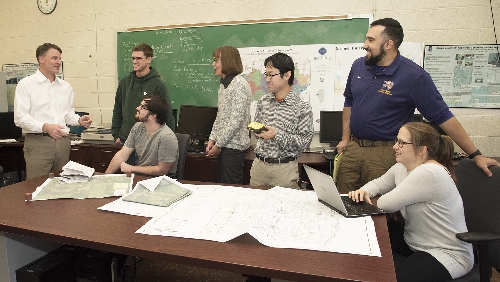University News
WIU GIS Students Participate in Building Tri-County 911 Network
December 16, 2016
MACOMB, IL – A mapping project by the Western Illinois University Geographic Information Systems (GIS) Center, managed by Director Chad Sperry, is giving students hands-on experience developing a 911 network from its roots and bringing upgraded and necessary emergency services to a group of counties in south central Illinois.
Phil McCarty, director of the newly-formed West Central Emergency Telephone Systems Board (ETSB), covering 911 operations in Greene, Calhoun and Morgan Counties, sought assistance from the WIU GIS Center to provide mapping services for a new plan to consolidate emergency dispatching, after seeing other mapping projects the WIU GIS office has completed, including a map book recently done for neighboring Schuyler County.
The new dispatch base will be located in Jacksonville (IL) and will provide services to all three counties.
"We are asking WIU to look at all of the addresses in the rural parts of Greene and Calhoun counties, including those which have rural route or post office box addresses," said McCarty. "This is not just an isolated project; they are working in conjunction with the post offices, the highway engineers and city and county governments."
Sperry added that this is an important project for the residents of that area, "because the citizens will have enhanced access to emergency services."
Greene and Calhoun Counties are among the handful of Illinois counties that don't yet have 911 service coverage. They, in turn, partnered with the existing 911 system in Morgan County to develop the new partnership. The consolidation is necessary because many residents have eliminated their landline in favor of cellular technology, thus reducing service fees collected to fund 911 services.
The work and travel to the impacted counties by WIU staff and students is paid for by grant funds from the Illinois State Police. Sperry said the project includes the hiring of several WIU graduate and undergraduate students, mostly with an interest in GIS, to perform a variety of services from mapping buildings to helping rename roads in the counties to make them easier for emergency service workers to find.
"Each student is assigned a role and a function," said Sperry. "This project provides an opportunity for the students to develop and hone skills that they will utilize through out their careers."
The work of the students is also overseen by WIU GIS Specialist Keisuke Nozaki.
"I do the quality checks," said Nozaki. "I also make sure the students are communicating well and working together to make sure there is no duplication of efforts."
Students are combing through the various GIS layers of the properties in Greene and Calhoun Counties and checking them for accuracy.
"We are in the office and field verifying data and studying aerial photography. We drive the roads and cross-reference postal, phone and mail records," said Sperry. "Postal workers will be consulted because matching the mailboxes to houses will probably be our biggest challenge."
WIU graduate geography student Alex Adams, of Macomb, is working on updating the addresses and road names on the 911 maps and incorporating the new house numbers into blocks.
"I have learned how much you can do for a community through this process," said Adams. "I know in this kind of work you can affect change."
Lexi Araoz, a senior geography and geographic information science major from Macomb, is working on re-naming the county roads according to a grid that emergency service providers can easily follow.
"This is an important real-life application of GIS, and it helps us see how it impacts a community," said Araoz.
WIU junior Edgar Rodriguez, of Macomb is approaching the project from his academic research as an emergency management major and GIS minor.
"I am working with the fire districts – if someone is late in responding to a 911 call they can't save someone's life," he said. "Based on the tax codes and land parcels we are defining the fire district boundaries. This allows me to see how to start a 911 system from the ground up. If you don't have a solid base, you won't be able to progress and take advantage of the changing technology."
McCarty said he has been impressed with the work of the students, as well as Sperry's leadership.
"They are definitely delivering accurate and timely results," said McCarty.
A third service provider, SD911 from Minnesota, is working with the telephone companies in the area to re-route telephone trunks, assist with postal coordination and add the new addresses to the phone system.
The hope is that the WIU GIS center will complete its work by February and that the new, combined 911 system will be online by the summer of 2017.
For more information about the WIU GIS Center, visit wiu.edu/GIS.
Posted By: Jodi Pospeschil (JK-Pospeschil@wiu.edu)
Office of University Communications & Marketing


Connect with us: